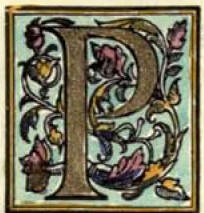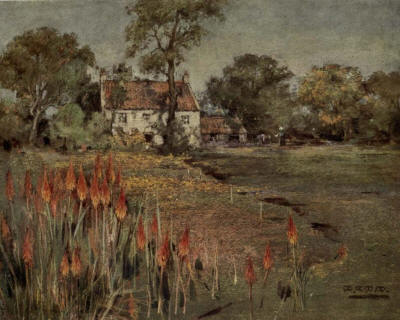|
 ASSING
from Raeden House over the hill-top known as the Cocket Hat, one comes
upon a wide extent of nursery ground and, forasmuch as our series of
Scottish garden types would not be complete without a sample of
commercial horticulture, Miss Wilson has chosen a corner of this ground
called Honey Braes, which forms a fitting subject for her art. The day
may come when this drawing may have an interest more than aesthetic; for
already this part of the nurseries has been marked off in building
plots, and the red-roofed house is doomed to disappear at no distant
date. It was under these red tiles that Mrs. Byron (nee Catherine Gordon
of Gight) lived with her son George, whom she described to her
sister-in-Jaw, Mrs. Leigh, as being "very well and really a charming
boy" in 1791. Seven years later the "charming boy" succeeded his
great-uncle, the "wicked Lord Byron," as sixth Lord Byron, with such
results upon English literature as we wot of. It suggests curious
commentary upon early training and what surprises may await those who
calculate upon its result, to read Byron's notes upon his start in
letters. "I had," he says, "a very serious, saturnine, but kind young
man, named Paterson, for my tutor. He was the son of my shoemaker, but a
good scholar, as is common with the Scotch. He was a rigid Presbyterian
also." ASSING
from Raeden House over the hill-top known as the Cocket Hat, one comes
upon a wide extent of nursery ground and, forasmuch as our series of
Scottish garden types would not be complete without a sample of
commercial horticulture, Miss Wilson has chosen a corner of this ground
called Honey Braes, which forms a fitting subject for her art. The day
may come when this drawing may have an interest more than aesthetic; for
already this part of the nurseries has been marked off in building
plots, and the red-roofed house is doomed to disappear at no distant
date. It was under these red tiles that Mrs. Byron (nee Catherine Gordon
of Gight) lived with her son George, whom she described to her
sister-in-Jaw, Mrs. Leigh, as being "very well and really a charming
boy" in 1791. Seven years later the "charming boy" succeeded his
great-uncle, the "wicked Lord Byron," as sixth Lord Byron, with such
results upon English literature as we wot of. It suggests curious
commentary upon early training and what surprises may await those who
calculate upon its result, to read Byron's notes upon his start in
letters. "I had," he says, "a very serious, saturnine, but kind young
man, named Paterson, for my tutor. He was the son of my shoemaker, but a
good scholar, as is common with the Scotch. He was a rigid Presbyterian
also."
The owner of this
nursery, Mr. James Cocker, is an enthusiast in his profession, one in
whose company an eager amateur will find no summer's day too long. Field
by field the speculative builder has encroached upon his border, and
field by field he has retreated further into the country. Roses are his
speciality; but there is much else to interest him who concerns himself,
like the present writer, more with natural species than with florists'
varieties. The first display to attract attention on this bracing June
morning was a breadth of St. Bernard's lily—the fine variety known as
Anthericum liliago majus or Algeriense. Myriads of milk-white, golden-anthered
blossoms of perfect shape waved in the breeze, suggesting irresistibly
the question—why is this lovely lily so seldom seen in private gardens?
The answer may be supposed to be that its flowering season coincides
with the summer meetings at Epsom and Ascot, when so many country people
of means and leisure, however little they may care personally for
racing, leave the country at its fairest to undergo the rush and
discomfort of a London season.
The Chilian Omrisia
coccinea, so chary of its brilliant flowers in most gardens, was thickly
set with scarlet tubes in an open, but rather shady, border. Alpine
anemones, both the white and the sulphur, were just over, but bore
traces of recent display in hundreds of seed-tufts on tall stems. Very
conspicuous and attractive was a seedling perennial lupine, bearing
spikes of clear salmon colour, and near it a starry firmament of
globe-flowers (Trollies), lemon-yellow, sulphur and fiery orange, none
of them, in our opinion, equal in grace and delicacy to the native T.
europous.
Pansies and violas were
in infinite variety and copious bloom, the pure tints of these easiest
of flowers being admirably shown up by the plan of planting them in
strips of different colours drawn diagonally across a long border.
Incarvillea grandiflora, hitherto reputed somewhat tender, here grows in
the open and on the flat as generously as its taller and better known
relative I. Delavayi; and that, as we all have learnt to our content,
combines the constitution of a dandelion with the refinement of a
gloxinia.
Sisyrinchium
odoratissimum I have not seen elsewhere. It is to be hoped that Mr.
Cocker will succeed in propagating it, for it is an interesting thing,
hanging out white bells striped with purple on airy stalks a foot and a
half high. The rarest treasure in the herbaceous section is a pure white
Alstroe neria chiles. i$, of which Mr. Cocker possesses a single plant,
obtained, after long and difficult negotiation, from an amateur who
raised it.
A pretty feature in these
nurseries is a pergola

of laburnum, which only
requires to be mixed with Wistaria to create a perfect summer dream. But
as Wistaria flowers uncertainly and sparingly thus far north, this
design might be carried out effectively in warmer districts. An
interesting example of the influence of scion upon stock may be seen in
this pergola. Laburnum with variegated leaves having been grafted upon
the ordinary species at a height of five feet or so, the stock has
responded by putting out variegated leaves at a considerable distance
below the graft. |
